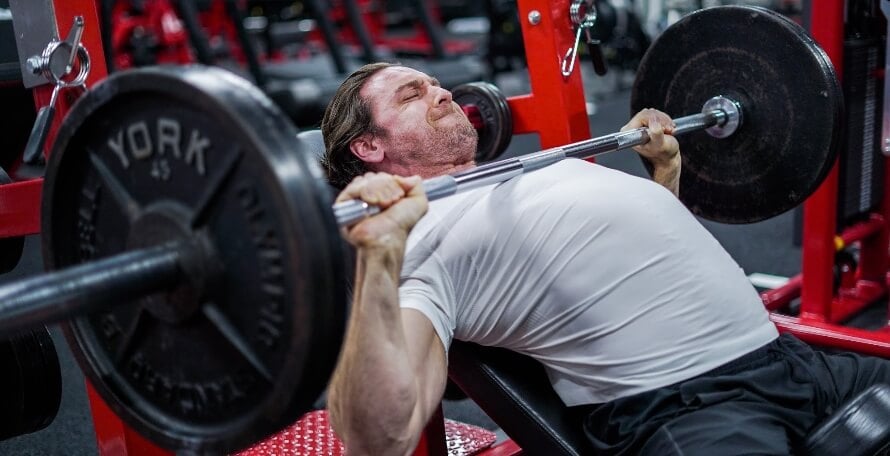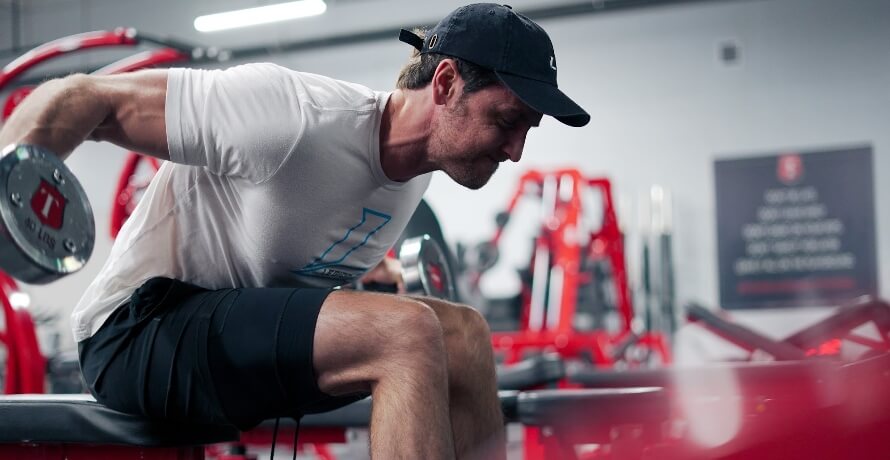Most individuals assume a hypertrophy coaching program means excessive reps, gentle weights, and chasing a pump till your limbs go numb.
It doesn’t.
In actuality, one of the best hypertrophy exercise programs look rather a lot like good power packages—heavy compound weightlifting, common development, and simply sufficient quantity to develop, however not a lot that you simply burn out.
This text reveals you precisely how one can stimulate hypertrophy (construct muscle) effectively.
You’ll find out how hypertrophy works, what truly drives muscle development, and how one can observe a hypertrophy plan that builds critical dimension and power—with out losing time or spinning your wheels.
Key Takeaways
Muscle hypertrophy is the scientific time period for a rise in muscle cell dimension.
To stimulate hypertrophy, you could create excessive ranges of mechanical pressure in your muscle fibers, and one of the simplest ways to do that is by lifting heavy weights.
The greatest hypertrophy packages concentrate on progressive overload and compound workouts, they usually steadiness depth and quantity in a approach that maximizes development with out burning you out.
To get essentially the most out of a hypertrophy exercise program, eat sufficient energy and protein, practice near failure, prioritize sleep, and deload each 8-to-10 weeks.
Following a hypertrophy coaching plan helps you construct muscle, makes managing your weight simpler, and dramatically improves your total well being.
What Is Hypertrophy?

Muscle hypertrophy is the scientific time period for a rise in muscle cell dimension.
Hyper means “over” or “extra,” and trophy means “development,” so muscle hypertrophy actually means the expansion of muscle cells.
Technically, you may obtain muscle hypertrophy by rising any of the three fundamental elements of muscle tissue—water, glycogen, or protein—although weightlifters are normally most inquisitive about rising the quantity of protein in muscle (also referred to as myofibrillar hypertrophy).
READ MORE: Good Query: What Is Muscle Hypertrophy?
Tips on how to Stimulate Hypertrophy
To simulate hypertrophy (construct muscle) you first must create plenty of mechanical pressure in your muscle fibers. One of the simplest ways to realize that is lifting heavy weights.
Excessive ranges of mechanical pressure activate proteins in muscle cells known as mechanosensors, which stimulate the physique to ramp up mammalian goal of rapamycin, or mTOR, an enzyme that enhances protein synthesis (the creation of latest muscle fibers).
But it surely’s not simply about lifting heavy weights. You additionally want to provide sufficient quantity of pressure over time. As an illustration, squatting as a lot weight as potential for a single rep creates tons of pressure, however with out sufficient reps or units, the expansion sign stays weak.
In different phrases, there’s a minimal quantity of pressure required to stimulate muscle development.
You additionally want to present your physique sufficient relaxation and “uncooked supplies”—primarily protein and energy—to truly construct new muscle. With out them, you blunt the muscle-building results of coaching and improve protein breakdown, which cancels out a few of your good points.
Now let’s break down how one can put all this collectively into an efficient hypertrophy coaching program.
Hypertrophy Coaching Program Fundamentals


To construct muscle effectively, your hypertrophy plan must observe a number of key rules. Right here’s what issues most.
Progressive Overload
To maximise the hypertrophic results of weightlifting, you will need to try so as to add weight or reps to each train in each exercise. This is called progressive overload, and it’s the only largest driver of muscle development.
To progressively overload your muscular tissues successfully, observe this rule: when you hit the highest of your rep vary for one set, add weight.
As an illustration, in case your hypertrophy coaching program requires 4-to-6 reps of the deadlift and also you get 6 reps for a set, add 10 kilos to your subsequent set.
Should you handle 3 or fewer reps with the brand new weight, scale back the load by 5 kilos to make sure you keep within the 4-to-6 rep vary.
Observe this sample of making an attempt so as to add reps or weight to each train in each exercise.
READ MORE: Double Development Information: Tips on how to Use Double Development to Achieve Muscle and Power
Coaching Quantity
To maximise hypertrophy, most analysis reveals you could practice every main muscle group with 10-to-20 weekly units. Doing greater than 20 would possibly produce higher outcomes for some, however development quickly diminishes past this level, so the additional work isn’t well worth the effort.
Coaching with very excessive volumes has sensible downsides, too: it’s time-consuming, and except your restoration (sleep, eating regimen, and many others.) is flawless, it’s onerous to maintain.
That’s why all good hypertrophy packages (just like the one under) embrace 10-to-20 weekly units for every main muscle group.
READ MORE: How Many Units Ought to You Do for Muscle Hypertrophy?
Coaching Depth
To make your hypertrophy coaching program as efficient as potential, take most of your units to inside 1-to-3 reps of failure—the purpose the place you may’t carry out one other rep with correct type.
To gauge whether or not you’re reaching this level, ask your self on the finish of every set: “If I needed to, what number of extra reps may I’ve executed with good type?”
If the reply is greater than two, improve the load or reps in your subsequent set to make it tougher.
READ MORE: Does Coaching to Failure Assist You Construct Extra Muscle? What Science Says
Train Choice
Analysis reveals that if you wish to maximize muscle hypertrophy, nothing beats compound weightlifting.
A compound train is any kind of train that trains a number of main muscle teams on the identical time, just like the squat, deadlift, and bench and overhead press.
Isolation workouts—people who contain only one joint and main muscle group at a time—nonetheless have a spot in a hypertrophy coaching program, but when constructing muscle is your fundamental purpose, you need to put most of your vitality into compound workouts.
Rep Vary
Regardless of what some “consultants” say, you don’t must do 20+ reps per set to construct muscle.
Whereas it’s potential to construct muscle utilizing excessive rep ranges, analysis reveals that they’re solely efficient in case you take every set to failure.
There are two issues with this coaching model:
Doing high-rep units is extraordinarily disagreeable (units take longer, really feel tougher, and trigger extra fatigue than lower-rep units).
Coaching to failure recurrently can improve your danger of harm.
By rising the load and doing fewer reps per set, nonetheless, you may produce a strong muscle- and strength-building stimulus with out busting a intestine or coaching to failure.
The Finest Hypertrophy Exercise Program


For many years, pure bodybuilders have used this 5-day hypertrophy exercise program to construct mass.
It really works so properly as a result of it consists of all one of the best muscle-building workouts and the proper steadiness of quantity and depth to spur fast development with out sporting you to a frazzle.
If the 5-day hypertrophy exercise program doesn’t suit your schedule, you may shorten it to a 4-day routine by skipping Day 5. And in case you’d favor to do a 3-day routine, skip Day 3 and Day 5.
Day 1: Push
Day 2: Pull
Day 3: Higher A
Day 4: Decrease
Day 5: Higher B
5 Tricks to Optimize Your Hypertrophy Coaching Program Outcomes


1. Eat sufficient energy and protein.
To maximize muscle and power acquire whereas following this hypertrophy coaching program, preserve a every day calorie surplus of round 110% of your complete every day vitality expenditure (TDEE). In different phrases, eat round 10% extra energy than your physique burns every day.
You additionally must eat sufficient protein to permit your muscular tissues to get well, restore, and develop successfully. Purpose to eat 0.8-to-1 gram of protein per pound of physique weight per day.
For personalised recommendation about precisely what number of energy to eat, how a lot of every macronutrient, and which meals you need to devour to achieve your health targets, take the Legion Food regimen Quiz.
2. Heat up appropriately.
Warming up initially of every exercise is essential for optimizing efficiency and stopping harm.
Right here’s the science–primarily based protocol I like to recommend:
Estimate the load you’ll use in your first onerous set of your first train.
Do 6 reps with about 50% of that weight and relaxation for 1 minute.
Do 4 reps with about 70% of that weight and relaxation for 1 minute.
After this, you’re able to deal with your onerous units in your first train and the remainder of your hypertrophy exercise.
3. Deload each 8-to-10 weeks.
A deload is a brief interval—normally per week—the place you deliberately scale back your coaching quantity or depth to decrease fatigue, ease joint and tendon pressure, and scale back psychological stress.
Whereas individuals debate one of the best deload technique, I like to recommend chopping quantity somewhat than depth. Analysis reveals this method is simpler for decreasing fatigue (the principle purpose) and helps preserve power, making it simpler to renew onerous coaching afterward.
How lengthy you’re taking between deloads is as much as you—some individuals get well sooner than others—however an excellent rule of thumb is each 8-to-10 weeks of onerous coaching.
Right here’s a easy method to do it:
Observe the identical exercises because the earlier week
Do 2 onerous units per train as an alternative of three
Use your regular working weights
For workouts you normally do within the 4-to-6 rep vary, do 3 reps per set
For workouts within the 6-to-8 rep vary, do 4 reps per set
4. Get sufficient sleep.
To get essentially the most out of your hypertrophy plan, you could sleep properly.
Getting 7-to-9 hours per night time improves temper, vitality, exercise efficiency, and restoration. It additionally helps muscle development by boosting anabolic hormones and decreasing muscle breakdown.
On high of that, it helps you keep on monitor together with your eating regimen by reducing cravings and bettering self-control, making it much less seemingly you’ll overeat.
5. Take the fitting dietary supplements.
These dietary supplements might help optimize your outcomes whereas following a hypertrophy exercise program:
Protein powder: Protein powder, akin to whey or casein, offers your physique with the vitamins wanted to construct muscle tissue and get well from exercises.
Creatine: Creatine boosts muscle and power acquire, improves anaerobic endurance, and reduces muscle injury and soreness out of your exercises.
Pre-workout: A high-quality pre-workout enhances vitality, temper, and focus, will increase power and endurance, and reduces fatigue.
(Should you’d like much more particular recommendation about which dietary supplements you need to take to achieve your well being and health targets, take the Legion Complement Finder Quiz, and in lower than a minute, you’ll know precisely what dietary supplements are best for you. Click on right here to test it out.)
The Advantages of Following a Hypertrophy Coaching Program


You now know what hypertrophy is, how one can stimulate it, and how one can practice for it successfully.
However why observe a hypertrophy coaching program plan within the first place?
Listed below are the principle advantages.
Muscle Development
The obvious profit: you’ll construct muscle. And that makes performing on a regular basis duties simpler, protects you towards harm, boosts your athletic efficiency, extends your life expectancy, and helps you preserve good metabolic well being.
And sure, extra muscle might also make you look higher.
Fats Loss
Lifting weights boosts your resting metabolic fee, serving to you burn extra energy even at relaxation. That’s as a result of muscle tissue is extra “metabolically lively” than fats.
It additionally triggers your muscular tissues to launch particular particles known as extracellular vesicles into your blood. As they depart your muscular tissues, they carry strands of genetic materials known as miR-1 to fats cells. When miR-1 is in muscle tissue, it hinders muscle development, however as soon as it’s deposited in fats cells, it hastens fats burning.
In different phrases, lifting weights causes delicate shifts within the expression of sure genes that assist long-term fats loss on the molecular degree.
Optimum Well being
Lifting weights improves nearly each marker of well being, together with . . .
It additionally lowers your danger of main ailments—like most cancers, heart problems, kind 2 diabetes, osteoporosis, and nonalcoholic fatty liver illness—and enhances psychological well being by boosting vanity, temper, and independence as you age.
FAQ #1: What’s one of the best hypertrophy routine for learners?
The hypertrophy coaching program on this article works nice for learners.
Should you’re model new to lifting, begin by coaching three days per week—it’s sufficient to construct muscle successfully whereas providing you with loads of time to get well. To do that, simply skip exercises 3 and 5.
That mentioned, in case you’re feeling as much as it and need the quickest outcomes, observe the complete program as written.
FAQ #2: How do you pronounce hypertrophy?
It’s pronounced hai-PUR-truh-fee, with the stress on the second syllable (PUR).
FAQ #3: Are drop units good for hypertrophy?
Analysis reveals that drop units are a wonderfully viable method to construct muscle—however they’re not higher than conventional coaching.
They’re additionally usually extra grueling. Repeatedly pushing to failure is extra uncomfortable and mentally draining than conventional units, which might make your exercises really feel much less satisfying. And since they don’t produce higher outcomes, most individuals favor to stay with common units.
That mentioned, in case you’re brief on time, drop units could be a useful gizmo. They allow you to pack extra work into much less time—so long as you’re prepared to endure a bit of.
FAQ #4: Ought to I am going to failure on each set for hypertrophy?
No—you don’t must go to failure on each set to construct muscle, and doing so may very well backfire.
Analysis reveals that coaching to failure isn’t higher than stopping a number of reps brief. It could actually additionally improve fatigue, harm your efficiency in later units, and make exercises much less satisfying.
As a substitute, end most units 1-to-3 reps shy of failure, particularly on compound workouts. If you wish to push to failure sometimes, reserve it for the final set of an isolation train.
FAQ #5: What rep vary is greatest for hypertrophy?
You can acquire muscle doing anyplace from ~3-to-30+ reps per set, so the “greatest” rep ranges for hypertrophy are largely those you get pleasure from essentially the most.
I sometimes suggest coaching in decrease rep ranges—like 4-to-6 or 6-to-8—for a number of sensible causes:
Once you practice with heavier weights, you may typically progress (improve the weights you raise) extra recurrently, which is motivating. It additionally helps you acquire power extra successfully, which turns into important for gaining muscle as you close to your genetic potential for development.
Lifting heavy weights feels much less fatiguing, which might make exercises extra satisfying. For instance, most individuals would like three 6-rep units of squats over three 20-rep units of squats, particularly in case you needed to transfer on to different taxing workouts just like the leg press and lunge.
Units of extra reps take longer to finish and tax your cardiovascular system greater than units of fewer reps, forcing you to take longer relaxation durations to catch your breath. Collectively, this provides vital time to your exercises.
Scientific References +
Schoenfeld, B. J. (2010). The mechanisms of muscle hypertrophy and their utility to resistance coaching. In Journal of Power and Conditioning Analysis (Vol. 24, Subject 10, pp. 2857–2872). J Power Cond Res.
Goldberg, A. L., et al. “Mechanism of Work-Induced Hypertrophy of Skeletal Muscle.” Medication and Science in Sports activities, vol. 7, no. 3, 1975, pp. 185–198, pubmed.ncbi.nlm.nih.gov/128681/.
Graham, Zachary A., et al. “Focal Adhesion Kinase and Its Function in Skeletal Muscle.” Journal of Muscle Analysis and Cell Motility, vol. 36, no. 4-5, 4 July 2015, pp. 305–315, Accessed 14 Nov. 2020.
Yoon, Mee-Sup. “MTOR as a Key Regulator in Sustaining Skeletal Muscle Mass.” Frontiers in Physiology, vol. 8, 17 Oct. 2017, Accessed 8 Might 2020.
MATTOCKS, KEVIN T., et al. “Practising the Take a look at Produces Power Equal to Increased Quantity Coaching.” Medication & Science in Sports activities & Train, vol. 49, no. 9, Sept. 2017, pp. 1945–1954, Accessed 27 Nov. 2020.
“View of the Resistance Coaching Dose-Response: Meta-Regressions Exploring the Effects of Weekly Quantity and Frequency on Muscle Hypertrophy and Power Achieve.” Sportrxiv.org, 2024, sportrxiv.org/index.php/server/preprint/view/460/967.
Gentil, P., Soares, S., & Bottaro, M. (2015). Single vs. Multi-joint resistance workouts: Results on muscle power and hypertrophy. Asian Journal of Sports activities Medication, 6(2), 1–5.
Schoenfeld, Brad J., et al. “Power and Hypertrophy Variations between Low- vs. Excessive-Load Resistance Coaching.” Journal of Power and Conditioning Analysis, vol. 31, no. 12, Dec. 2017, pp. 3508–3523,
Ribeiro, Alex S., et al. “Acute Results of Totally different Coaching Masses on Affective Responses in Resistance-Educated Males.” Worldwide Journal of Sports activities Medication, vol. 40, no. 13, 9 Sept. 2019, pp. 850–855, Accessed 22 Mar. 2020.
Schoenfeld, Brad J., et al. “Loading Suggestions for Muscle Power, Hypertrophy, and Native Endurance: A Re-Examination of the Repetition Continuum.” Sports activities, vol. 9, no. 2, 22 Feb. 2021, p. 32, pmc.ncbi.nlm.nih.gov/articles/PMC7927075/,
Helms, E. R., Aragon, A. A., & Fitschen, P. J. (2014). Proof-based suggestions for pure bodybuilding contest preparation: Vitamin and supplementation. In Journal of the Worldwide Society of Sports activities Vitamin (Vol. 11, Subject 1, p. 20). BioMed Central Ltd.
Ribeiro, Bruno, et al. “The Function of Particular Heat-up throughout Bench Press and Squat Workout routines: A Novel Method.” Worldwide Journal of Environmental Analysis and Public Well being, vol. 17, no. 18, 22 Sept. 2020, p. 6882,
BICKEL, C. SCOTT, et al. “Train Dosing to Retain Resistance Coaching Variations in Younger and Older Adults.” Medication & Science in Sports activities & Train, vol. 43, no. 7, July 2011, pp. 1177–1187,
Izquierdo, Mikel, et al. “Detraining and Tapering Results on Hormonal Responses and Power Efficiency.” The Journal of Power and Conditioning Analysis, vol. 21, no. 3, 2007, p. 768, Accessed 15 Apr. 2020.
Bosquet, Laurent, et al. “Results of Tapering on Efficiency.” Medication & Science in Sports activities & Train, vol. 39, no. 8, Aug. 2007, pp. 1358–1365, pubmed.ncbi.nlm.nih.gov/17762369/,
Mujika, I. “The Affect of Coaching Traits and Tapering on the Adaptation in Extremely Educated People: A Overview.” Worldwide Journal of Sports activities Medication, vol. 19, no. 07, Oct. 1998, pp. 439–446,
Hamlin, Michael J., et al. “The Impact of Sleep High quality and Amount on Athlete’s Well being and Perceived Coaching High quality.” Frontiers in Sports activities and Energetic Residing, vol. 3, no. 3, 10 Sept. 2021,
Kirschen, Gregory W., et al. “The Affect of Sleep Length on Efficiency amongst Aggressive Athletes.” Medical Journal of Sport Medication, vol. 30, no. 5, June 2018, p. 1,
Nedeltcheva, A. V., Kilkus, J. M., Imperial, J., Schoeller, D. A., & Penev, P. D. (2010). Inadequate sleep undermines dietary efforts to scale back adiposity. Annals of Inner Medication, 153(7), 435–441.
Yang, Chia-Lun, et al. “Elevated Starvation, Meals Cravings, Meals Reward, and Portion Measurement Choice after Sleep Curtailment in Girls with out Weight problems.” Vitamins, vol. 11, no. 3, 19 Mar. 2019, www.ncbi.nlm.nih.gov/pmc/articles/PMC6470707/,
Alahmary, Sarah A., et al. “Relationship between Added Sugar Consumption and Sleep High quality amongst College College students: A Cross-Sectional Research.” American Journal of Life-style Medication, vol. 16, no. 1, 23 Aug. 2019, p. 155982761987047,
Tucker, Robin M, et al. “The Affect of Sleep on Human Style Operate and Notion: A Systematic Overview.” Journal of Sleep Analysis, 18 June 2024,
Stokes, T., Hector, A. J., Morton, R. W., McGlory, C., & Phillips, S. M. (2018). Current views concerning the function of dietary protein for the promotion of muscle hypertrophy with resistance train coaching. In Vitamins (Vol. 10, Subject 2). MDPI AG.
Jd, Department. “Impact of Creatine Supplementation on Physique Composition and Efficiency: A Meta-Evaluation.” Worldwide Journal of Sport Vitamin and Train Metabolism, 1 June 2003, pubmed.ncbi.nlm.nih.gov/12945830/.
Eckerson, Joan M., et al. “Impact of Creatine Phosphate Supplementation on Anaerobic Working Capability and Physique Weight after Two and Six Days of Loading in Males and Girls.” The Journal of Power and Conditioning Analysis, vol. 19, no. 4, 2005, p. 756,
Bassit, Reinaldo Abunasser, et al. “Impact of Quick-Time period Creatine Supplementation on Markers of Skeletal Muscle Injury after Strenuous Contractile Exercise.” European Journal of Utilized Physiology, vol. 108, no. 5, 3 Dec. 2009, pp. 945–955,
THOMAS, MICHAEL H, and STEVE P BURNS. “Growing Lean Mass and Power: A Comparability of Excessive Frequency Power Coaching to Decrease Frequency Power Coaching.” Worldwide Journal of Train Science, vol. 9, no. 2, Apr. 2016, p. 159, pmc.ncbi.nlm.nih.gov/articles/PMC4836564/.
Jadczak, Agathe D., et al. “Effectiveness of Train Interventions on Bodily Operate in Group-Dwelling Frail Older Folks.” JBI Database of Systematic Critiques and Implementation Experiences, vol. 16, no. 3, Mar. 2018, pp. 752–775, Accessed 21 June 2019.
Levinger, I., et al. “The Impact of Resistance Coaching on Useful Capability and High quality of Life in People with Excessive and Low Numbers of Metabolic Threat Components.” Diabetes Care, vol. 30, no. 9, 11 June 2007, pp. 2205–2210,
Lauersen, Jeppe Bo, et al. “The Effectiveness of Train Interventions to Stop Sports activities Accidents: A Systematic Overview and Meta-Evaluation of Randomised Managed Trials.” British Journal of Sports activities Medication, vol. 48, no. 11, 7 Oct. 2014, pp. 871–877, bjsm.bmj.com/content material/48/11/871,
Suchomel, Timothy J., et al. “The Significance of Muscular Power: Coaching Issues.” Sports activities Medication, vol. 48, no. 4, 25 Jan. 2018, pp. 765–785, pubmed.ncbi.nlm.nih.gov/29372481/,
Rodríguez-Rosell, David, et al. “Physiological and Methodological Facets of Fee of Power Growth Evaluation in Human Skeletal Muscle.” Medical Physiology and Useful Imaging, vol. 38, no. 5, 20 Dec. 2017, pp. 743–762,
Seitz, Laurent B., et al. “Will increase in Decrease-Physique Power Switch Positively to Dash Efficiency: A Systematic Overview with Meta-Evaluation.” Sports activities Medication, vol. 44, no. 12, 25 July 2014, pp. 1693–1702.
“American Faculty of Sports activities Medication Place Stand. Train and Bodily Exercise for Older Adults.” Medication and Science in Sports activities and Train, vol. 30, no. 6, 1 June 1998, pp. 992–1008, pubmed.ncbi.nlm.nih.gov/9624662/. Accessed 6 Mar. 2021.
Kim, Gyuri, and Jae Hyeon Kim. “Affect of Skeletal Muscle Mass on Metabolic Well being.” Endocrinology and Metabolism, vol. 35, no. 1, 2020, p. 1,
MacKenzie-Shalders, Kristen, et al. “The Impact of Train Interventions on Resting Metabolic Fee: A Systematic Overview and Meta-Evaluation.” Journal of Sports activities Sciences, vol. 38, no. 14, 12 Might 2020, pp. 1635–1649,
Farinatti, Paulo TV, and Antonio G Castinheiras Neto. “The Impact of Between-Set Relaxation Intervals on the Oxygen Uptake throughout and after Resistance Train Periods Carried out with Giant- and Small-Muscle Mass.” Journal of Power and Conditioning Analysis, vol. 25, no. 11, Nov. 2011, pp. 3181–3190,
Fatouros, Ioannis G., et al. “Depth of Resistance Train Determines Adipokine and Resting Power Expenditure Responses in Obese Aged People.” Diabetes Care, vol. 32, no. 12, 3 Sept. 2009, pp. 2161–2167, Accessed 1 Nov. 2022.
Vechetti, Ivan J., et al. “The Function of Extracellular Vesicles in Skeletal Muscle and Systematic Adaptation to Train.” The Journal of Physiology, vol. 599, no. 3, 18 Feb. 2020, pp. 845–861, Accessed 19 Might 2022.
Chen, Jian-Fu, et al. “The Function of MicroRNA-1 and MicroRNA-133 in Skeletal Muscle Proliferation and Differentiation.” Nature Genetics, vol. 38, no. 2, 1 Feb. 2006, pp. 228–233, www.ncbi.nlm.nih.gov/pubmed/16380711,
Lopez, Pedro, et al. “Resistance Coaching Effectiveness on Physique Composition and Physique Weight Outcomes in People with Obese and Weight problems throughout the Lifespan: A Systematic Overview and Meta‐Evaluation.” Weight problems Critiques, vol. 23, no. 5, 21 Feb. 2022, Accessed 8 Might 2022.
de Sousa, Evitom Corrêa, et al. “Resistance Coaching Alone Reduces Systolic and Diastolic Blood Stress in Prehypertensive and Hypertensive People: Meta-Evaluation.” Hypertension Analysis, vol. 40, no. 11, 3 Aug. 2017, pp. 927–931,
Bweir, Salameh, et al. “Resistance Train Coaching Lowers HbA1c Greater than Cardio Coaching in Adults with Sort 2 Diabetes.” Diabetology & Metabolic Syndrome, vol. 1, no. 1, 2009, p. 27, Accessed 1 Aug. 2019.
Paquin, Jasmine, et al. “Exercising for Insulin Sensitivity – Is There a Mechanistic Relationship with Quantitative Modifications in Skeletal Muscle Mass?” Frontiers in Physiology, vol. 12, 2021, p. 656909, pubmed.ncbi.nlm.nih.gov/34054574/,
Ajayi-Vincent, O, and M Adesina. “EFFECTS of RESISTANCE TRAINING on the BLOOD LIPID VARIABLES of YOUNG ADULTS.” Of Human Kinetics and Well being Schooling, vol. 9, no. 12, 2013, pp. 1857–7881, core.ac.uk/obtain/pdf/236412208.pdf. Accessed 13 Apr. 2025.
Villareal, Dennis T., et al. “Cardio or Resistance Train, or Each, in Weight-reduction plan Overweight Older Adults.” New England Journal of Medication, vol. 376, no. 20, 18 Might 2017, pp. 1943–1955, www.ncbi.nlm.nih.gov/pmc/articles/PMC5552187/pdf/nihms889796.pdf,
Hong, A Ram, and Sang Wan Kim. “Results of Resistance Train on Bone Well being.” Endocrinology and Metabolism, vol. 33, no. 4, 2018, p. 435, pmc.ncbi.nlm.nih.gov/articles/PMC6279907/,
Boyle, Patricia A., et al. “Affiliation of Muscle Power with the Threat of Alzheimer Illness and the Fee of Cognitive Decline in Group-Dwelling Older Individuals.” Archives of Neurology, vol. 66, no. 11, 1 Nov. 2009, Accessed 22 Nov. 2019.
Hagstrom, Amanda D., et al. “The Impact of Resistance Coaching on Markers of Immune Operate and Irritation in Beforehand Sedentary Girls Recovering from Breast Most cancers: A Randomized Managed Trial.” Breast Most cancers Analysis and Therapy, vol. 155, no. 3, 28 Jan. 2016, pp. 471–482, Accessed 26 Sept. 2020.
Garatachea, Nuria, et al. “Elite Athletes Dwell Longer than the Common Inhabitants: A Meta-Evaluation.” Mayo Clinic Proceedings, vol. 89, no. 9, Sept. 2014, pp. 1195–1200, www.sciencedirect.com/science/article/abs/pii/S0025619614005199,
Stamatakis, Emmanuel, et al. “Does Power-Selling Train Confer Distinctive Well being Advantages? A Pooled Evaluation of Information on 11 Inhabitants Cohorts with All-Trigger, Most cancers, and Cardiovascular Mortality Endpoints.” American Journal of Epidemiology, vol. 187, no. 5, 31 Oct. 2017, pp. 1102–1112, Accessed 28 Jan. 2020.
Lee, JungHoon, et al. “Resistance Coaching for Glycemic Management, Muscular Power, and Lean Physique Mass in Outdated Sort 2 Diabetic Sufferers: A Meta-Evaluation.” Diabetes Remedy, vol. 8, no. 3, 5 Apr. 2017, pp. 459–473, hyperlink.springer.com/article/10.1007/s13300-017-0258-3,
Hashida, Ryuki, et al. “Cardio vs. Resistance Train in Non-Alcoholic Fatty Liver Illness: A Systematic Overview.” Journal of Hepatology, vol. 66, no. 1, Jan. 2017, pp. 142–152, Accessed 27 Aug. 2020.
Ciccolo, Joseph T, et al. “Muscular Power Is Related to Self-Esteem in Faculty Males however Not Girls.” Journal of Well being Psychology, vol. 21, no. 12, 11 July 2016, pp. 3072–3078, Accessed 5 Dec. 2020.
Gordon, Brett R., et al. “Affiliation of Efficacy of Resistance Train Coaching with Depressive Signs.” JAMA Psychiatry, vol. 75, no. 6, 1 June 2018, p. 566, jamanetwork.com/journals/jamapsychiatry/article-abstract/2680311,
Khodadad Kashi, Sholeh, et al. “A Systematic Overview and Meta-Evaluation of Resistance Coaching on High quality of Life, Despair, Muscle Power, and Useful Train Capability in Older Adults Aged 60 Years or Extra.” Organic Analysis for Nursing, vol. 25, no. 1, 13 Aug. 2022, p. 109980042211209,
Coleman, Max, et al. “Muscular Variations in Drop Set vs. Conventional Coaching: A Meta-Evaluation.” Worldwide Journal of Power and Conditioning, vol. 2, no. 1, 28 Nov. 2022,
Refalo, Martin C., et al. “Affect of Resistance Coaching Proximity-To-Failure on Skeletal Muscle Hypertrophy: A Systematic Overview with Meta-Evaluation.” Sports activities Medication, vol. 53, no. 3, 5 Nov. 2022,
Schoenfeld, Brad J., et al. “Results of Totally different Quantity-Equated Resistance Coaching Loading Methods on Muscular Variations in Effectively-Educated Males.” Journal of Power and Conditioning Analysis, vol. 28, no. 10, Oct. 2014, pp. 2909–2918,
Kubo, Keitaro, et al. “Results of 4, 8, and 12 Repetition Most Resistance Coaching Protocols on Muscle Quantity and Power.” Journal of Power and Conditioning Analysis, vol. 35, no. 4, Apr. 2020, p. 1,
Baz-Valle, Eneko, et al. “Complete Variety of Units as a Coaching Quantity Quantification Methodology for Muscle Hypertrophy.” Journal of Power and Conditioning Analysis, vol. Publish Forward of Print, no. 3, 30 July 2018,
Source link



